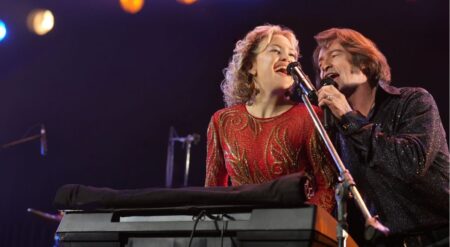
Zack Snyder’s Justice League is an HBO Max Original film, directed by Zack Snyder and written by Chris Terrio. The film takes place after the events of Batman V. Superman, with Batman (Ben Affleck) and Wonder Woman (Gal Gadot) aiming to recruit a team of superpowered beings in the wake of Superman’s (Henry Cavill) death. They manage to convince Aquaman (Jason Momoa), The Flash (Ezra Miller) and Victor Stone/Cyborg (Ray Fisher) to join them in battle against the demonic Steppenwolf (Ciarán Hinds), who seeks a trio of shapeshifting Mother Boxes on behalf of his master: the malevolent Darkseid (Ray Porter).
To discuss this film, we first have to look at how it came about. Snyder and his wife Deborah, who serves as producer on the film, departed production of Justice League in 2017 after the loss of their daughter Autumn, whom they emotionally dedicate the film to in a title card before the end credits. Joss Whedon was hired to reshoot and rewrite vast portions of the film, which was critically panned and sputtered out at the box office. Snyder’s most fervent fans insisted that the director’s original cut was out there, and finally in 2020 the “Snyder Cut” was announced-with WarnerMedia handing Snyder $70 million to complete visual effects and shoot a new sequence.
The end result is perhaps a massive overdose of everything one either loves or hates about Snyder’s work. Slo-motion action sequences, needle drops with on-the-nose lyrics, and overt religious imagery pepper the film’s four-hour runtime. It’s that last one that felt personally irritating for me: I don’t mind an allegory or two, but when Superman flies in a Jesus pose and Darkseid’s homeworld of Apokolips bears resemblance to a hellish church even the most fervent Biblical scholar would feel overwhelmed. Much like Patty Jenkins’ Wonder Woman 1984, this often feels like the first draft of a film.
The four hour running time also isn’t justified, even though Snyder breaks it up into six chapters and an epilogue. I have nothing against long movies, but the pacing should help build character. And while certain characters are fleshed out-particularly the other members of the League-others, such as Superman and his supporting cast, get the shaft. I’ve seen this film compared to Lord of the Rings and Snyder said during the original production that he drew inspiration from Seven Samurai. The difference between those films and Snyder’s is that they move at a pace that allows viewers to get invested in the world and its characters: with Zack Snyder’s Justice League, scenes feel double the length that they need to be. An example: the opening with Bruce Wayne riding into an Icelandic village to find Aquaman takes up nearly three minutes. Similarly, the epilogue feels more like an excuse to revisit the “Knightmare” future from Batman v Superman and Batman’s rivalry with the Joker (Jared Leto.) I feel that there is a good 3-hour film buried within the 4-hour runtime.
It also doesn’t help that the plot of this film is the same as the theatrical version, and that Steppenwolf remains a fairly bland villain. Though his design is altered to make him more frightening with spiked armor and clawed hands, and a backstory hints at tension with Darkseid, he still comes off as a generic “conquer the world” villain. Darkseid himself cuts a properly menacing figure due to Porter’s performance: his speech about seeking the Anti-Life Equation is utterly chilling. Had Darkseid served as the antagonist from the jump, I feel the film could have really popped.
The character who benefits the most from the expanded runtime is Fisher’s Cyborg. Victor’s anger at his father for transforming him into a cyborg and his grief over losing his mother are palpable; his growth into his powers and his rapport with Wonder Woman and Flash are another highlight of the film. It all leads up to a supercharged emotional scene where Cyborg declares, “I’m not broken. And I’m not alone.” Given Fisher’s outspokeness about Whedon’s unprofessional conduct during reshoots, and his performance, I’m saddened that we won’t see more of him as Cyborg-but I hope this isn’t the end of his career.
Despite the glacial pacing, the film actually has some visually striking images. Snyder’s strength for composing striking images comes to the forefront here; it’s quite fitting for a superhero team like the Justice League. One image in the final battle features the team leaping into action, which feels ripped from the pages of a comic. Another features a massive battle sequence set in ancient times, which is reminiscent of Snyder’s previous film 300. Also adding to the “epic” feel is composer Tom Holkenborg/Junkie XL, who returns to score the film. The main theme, “The Crew At Warpower,” is worth a listen.
Zack Snyder’s Justice League is an improvement on the theatrical version, but also an overindulgent expression of its director’s vision. Snyder’s hardcore fans who campaigned for the film will no doubt enjoy it, though I feel mileage will vary with other audience members. Hopefully Snyder’s next film, Army of the Dead, avoids the same pitfalls this film did.
Zack Snyder’s Justice League is currently available to stream on HBO Max.
Zach Snyder's Justice League
-
Rating - 6/106/10
TL;DR
Zack Snyder’s Justice League is an improvement on the theatrical version, but also an overindulgent expression of its director’s vision. Snyder’s hardcore fans who campaigned for the film will no doubt enjoy it, though I feel mileage will vary with other audience members. Hopefully Snyder’s next film, Army of the Dead, avoids the same pitfalls this film did.








